SAAB 9-5 2003 User Guide
Manufacturer: SAAB, Model Year: 2003, Model line: 9-5, Model: SAAB 9-5 2003Pages: 288, PDF Size: 16.78 MB
Page 11 of 288
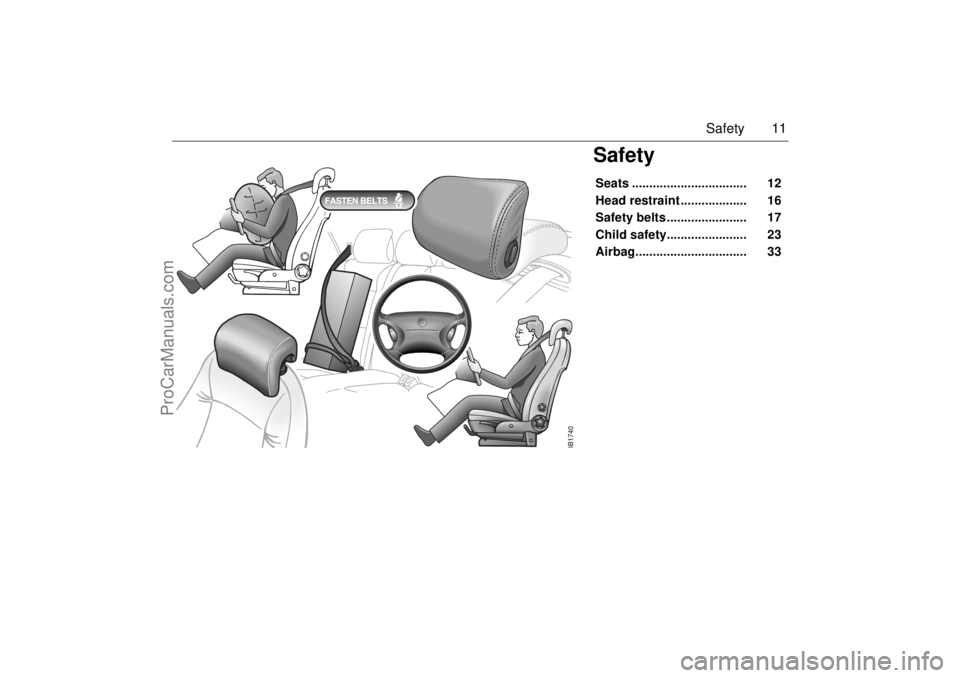
11 Safety
SafetySeats ................................. 12
Head restraint ................... 16
Safety belts ....................... 17
Child safety....................... 23
Airbag................................ 33
IB1740
ProCarManuals.com
Page 12 of 288
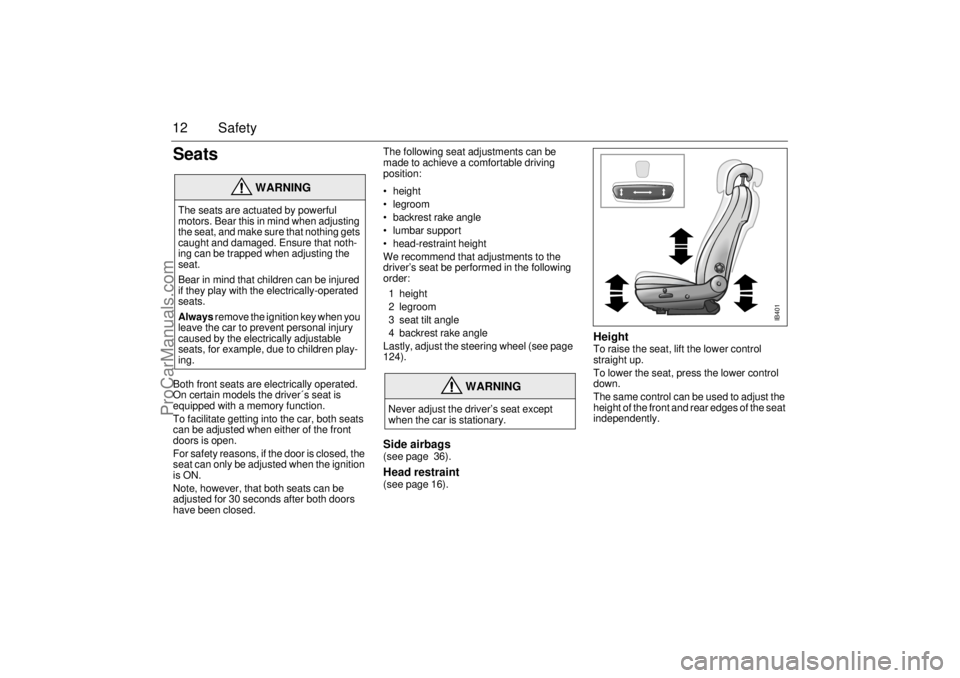
12 SafetySeats Both front seats are electrically operated.
On certain models the driver´s seat is
equipped with a memory function.
To facilitate getting into the car, both seats
can be adjusted when either of the front
doors is open.
For safety reasons, if the door is closed, the
seat can only be adjusted when the ignition
is ON.
Note, however, that both seats can be
adjusted for 30 seconds after both doors
have been closed. The following seat adjustments can be
made to achieve a comfortable driving
position:
height
legroom
backrest rake angle
lumbar support
head-restraint height
We recommend that adjustments to the
driver’s seat be performed in the following
order:
1height
2 legroom
3 seat tilt angle
4 backrest rake angle
Lastly, adjust the steering wheel (see page
124).
Side airbags (see page 36).Head restraint(see page 16).
Height To raise the seat, lift the lower control
straight up.
To lower the seat, press the lower control
down.
The same control can be used to adjust the
height of the front and rear edges of the seat
independently.
WARNING
The seats are actuated by powerful
motors. Bear this in mind when adjusting
the seat, and make sure that nothing gets
caught and damaged. Ensure that noth-
ing can be trapped when adjusting the
seat.
Bear in mind that children can be injured
if they play with the electrically-operated
seats.
Always remove the ignition key when you
leave the car to prevent personal injury
caused by the electrically adjustable
seats, for example, due to children play-
ing.
WARNING
Never adjust the driver’s seat except
when the car is stationary.
IB401
ProCarManuals.com
Page 13 of 288
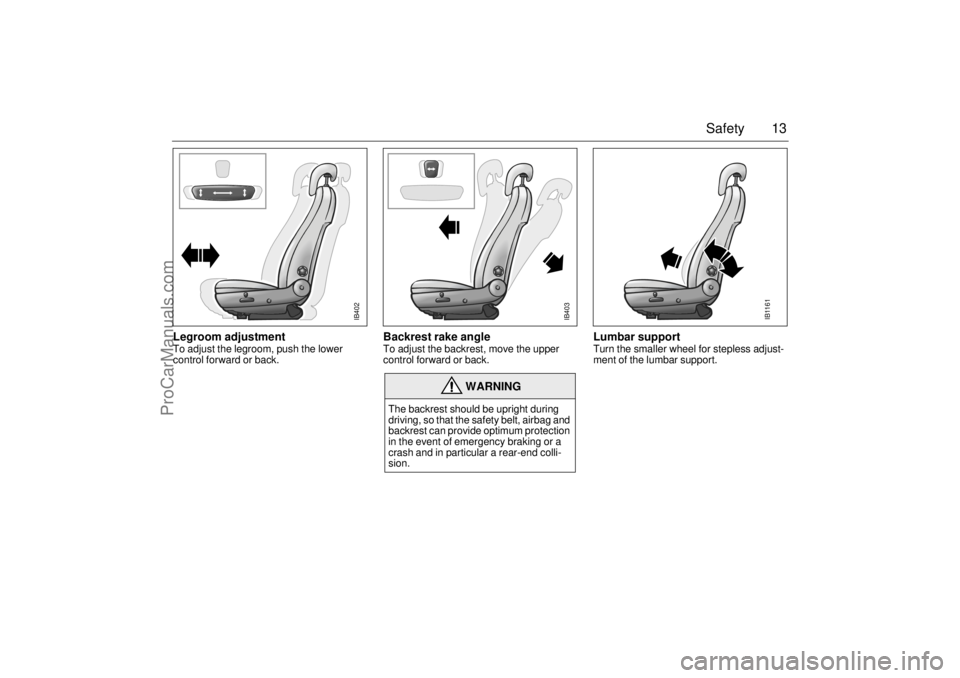
13 Safety
Legroom adjustment To adjust the legroom, push the lower
control forward or back.
Backrest rake angle To adjust the backrest, move the upper
control forward or back.
Lumbar supportTurn the smaller wheel for stepless adjust-
ment of the lumbar support.
WARNING
The backrest should be upright during
driving, so that the safety belt, airbag and
backrest can provide optimum protection
in the event of emergency braking or a
crash and in particular a rear-end colli-
sion.
IB402
IB403
IB1161
ProCarManuals.com
Page 14 of 288
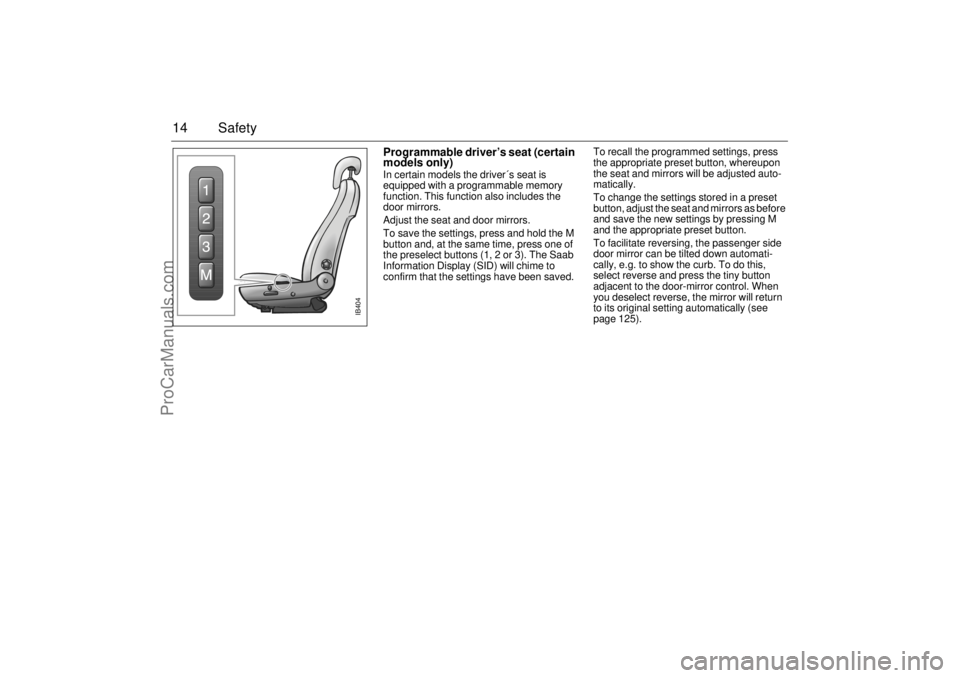
14 Safety
Programmable driver’s seat (certain
models only) In certain models the driver´s seat is
equipped with a programmable memory
function. This function also includes the
door mirrors.
Adjust the seat and door mirrors.
To save the settings, press and hold the M
button and, at the same time, press one of
the preselect buttons (1, 2 or 3). The Saab
Information Display (SID) will chime to
confirm that the settings have been saved.To recall the programmed settings, press
the appropriate preset button, whereupon
the seat and mirrors will be adjusted auto-
matically.
To change the settings stored in a preset
button, adjust the seat and mirrors as before
and save the new settings by pressing M
and the appropriate preset button.
To facilitate reversing, the passenger side
door mirror can be tilted down automati-
cally, e.g. to show the curb. To do this,
select reverse and press the tiny button
adjacent to the door-mirror control. When
you deselect reverse, the mirror will return
to its original setting automatically (see
page 125).
IB404
ProCarManuals.com
Page 15 of 288
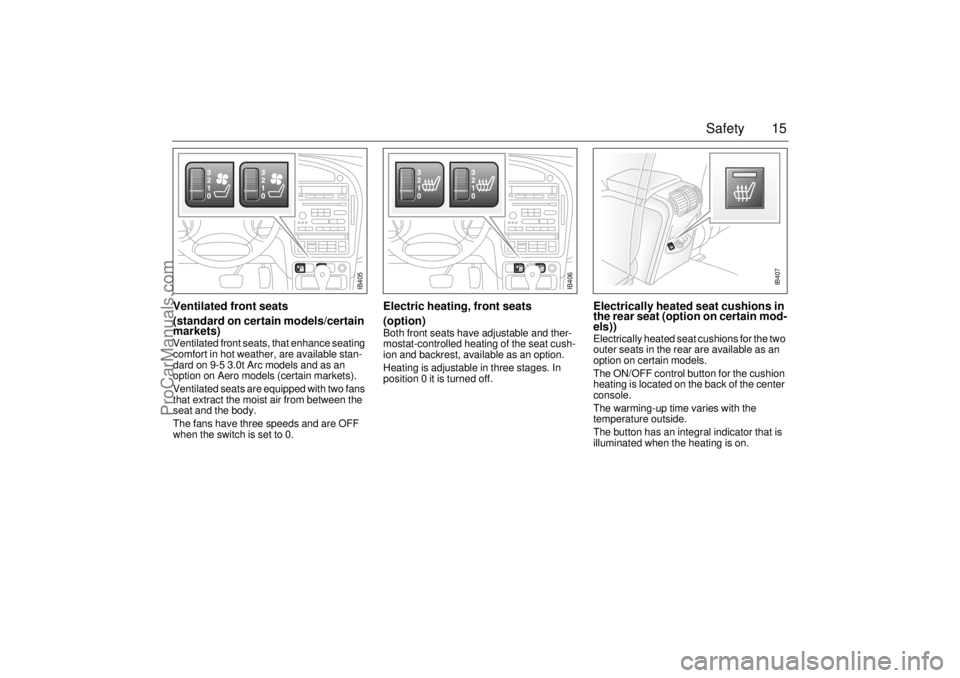
15 Safety
Ventilated front seats
(standard on certain models/certain
markets) Ventilated front seats, that enhance seating
comfort in hot weather, are available stan-
dard on 9-5 3.0t Arc models and as an
option on Aero models (certain markets).
Ventilated seats are equipped with two fans
that extract the moist air from between the
seat and the body.
The fans have three speeds and are OFF
when the switch is set to 0.
Electric heating, front seats
(option)Both front seats have adjustable and ther-
mostat-controlled heating of the seat cush-
ion and backrest, available as an option.
Heating is adjustable in three stages. In
position 0 it is turned off.
Electrically heated seat cushions in
the rear seat (option on certain mod-
els))Electrically heated seat cushions for the two
outer seats in the rear are available as an
option on certain models.
The ON/OFF control button for the cushion
heating is located on the back of the center
console.
The warming-up time varies with the
temperature outside.
The button has an integral indicator that is
illuminated when the heating is on.
IB405
IB406
IB407
ProCarManuals.com
Page 16 of 288

16 SafetyHead restraintThe front seats in the Saab 9-5 are
equipped with Saab Active Head Restraints
(SAHRs). These reduce the risk of whiplash
injury if the car is hit from behind.
In the event of a rear-end crash, the body is
forced back against the backrest. This, in
turn, causes the mechanism to press the
head restraint forward and upward, thus
limiting the backward movement of the
head.
The SAHR is a mechanical system, actu-
ated by body weight. The mechanism is built
into the top of the backrest, where it is
connected to the head restraint.
Therefore, the SAHR does not need to be
replaced after a minor rear-end crash.The head restraint can be raised or lowered
and is adjustable in various positions.
Raising: grasp the head restraint on both
sides and pull it straight up.
Lowering: press the catch on the left-hand
side of the attaching point and press down
the head restraint.
Rear-seat head restraints9-5 Sedan: The rear head restraints have
three adjustment positions for passenger
comfort.
They can also be folded down to increase
the driver’s rearward vision when the seat is
unoccupied.
9-5 Wagon: The height of the rear head
restraints can be adjusted by depressing
the catch on the left-hand collar in the same
way as the front head restraints.
WARNING
Adjust the head restraint so that your
head is optimally supported and the
center of the head restraint is at ear
height, thus reducing the likelihood of
neck injury in a crash.
Raise the head restraints in the seat
that are occupied.
IB460
IB400
ProCarManuals.com
Page 17 of 288

17 Safety
Safety belts Three-point inertia-reel safety belts are
provided for all seats.
Research has established that it is just as
dangerous for rear seat passengers not to
wear their safety belts as it is for front seat
passengers.
Bear in mind that in certain states it is a legal
requirement for all occupants of the car to
wear a safety belt.
Safety-belt reminderWhen the ignition is switched on, the ”fasten
belts” reminder will light up until the driver
fastens the safety belt. In addition an audi-
ble signal sounds for 6 seconds, or until the
driver fastens his belt.
WARNING
Safety belts must be worn at all times by
all car occupants.
Child safety, see page 23.
Check that the locking tongue is properly
locked in the belt lock.
WARNING
In the event of a crash, the rear-seat
passengers not wearing a seatbelt will
thrown forward against the front-seat
backrests. The stresses imposed on the
front seat passengers and belts are multi-
plied and can result in needless injury or
even death for all car occupants.
WARNING
Adjustments of the safety belt should be
done when the car is stationary so that
attention to traffic is not reduced.
IB409
FASTEN BELTS
ProCarManuals.com
Page 18 of 288
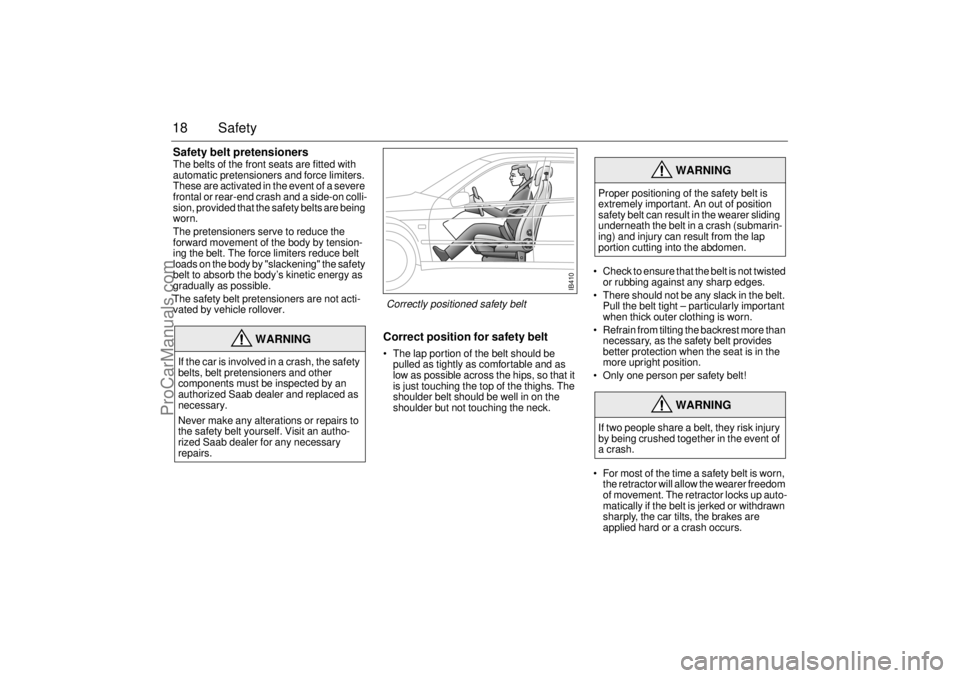
18 SafetySafety belt pretensionersThe belts of the front seats are fitted with
automatic pretensioners and force limiters.
These are activated in the event of a severe
frontal or rear-end crash and a side-on colli-
sion, provided that the safety belts are being
worn.
The pretensioners serve to reduce the
forward movement of the body by tension-
ing the belt. The force limiters reduce belt
loads on the body by "slackening" the safety
belt to absorb the body’s kinetic energy as
gradually as possible.
The safety belt pretensioners are not acti-
vated by vehicle rollover.
Correct position for safety belt The lap portion of the belt should be
pulled as tightly as comfortable and as
low as possible across the hips, so that it
is just touching the top of the thighs. The
shoulder belt should be well in on the
shoulder but not touching the neck.
Check to ensure that the belt is not twisted
or rubbing against any sharp edges.
There should not be any slack in the belt.
Pull the belt tight – particularly important
when thick outer clothing is worn.
Refrain from tilting the backrest more than
necessary, as the safety belt provides
better protection when the seat is in the
more upright position.
Only one person per safety belt!
For most of the time a safety belt is worn,
the retractor will allow the wearer freedom
of movement. The retractor locks up auto-
matically if the belt is jerked or withdrawn
sharply, the car tilts, the brakes are
applied hard or a crash occurs.
WARNING
If the car is involved in a crash, the safety
belts, belt pretensioners and other
components must be inspected by an
authorized Saab dealer and replaced as
necessary.
Never make any alterations or repairs to
the safety belt yourself. Visit an autho-
rized Saab dealer for any necessary
repairs.
WARNING
Proper positioning of the safety belt is
extremely important. An out of position
safety belt can result in the wearer sliding
underneath the belt in a crash (submarin-
ing) and injury can result from the lap
portion cutting into the abdomen.
WARNING
If two people share a belt, they risk injury
by being crushed together in the event of
a crash.
IB410
Correctly positioned safety belt
ProCarManuals.com
Page 19 of 288
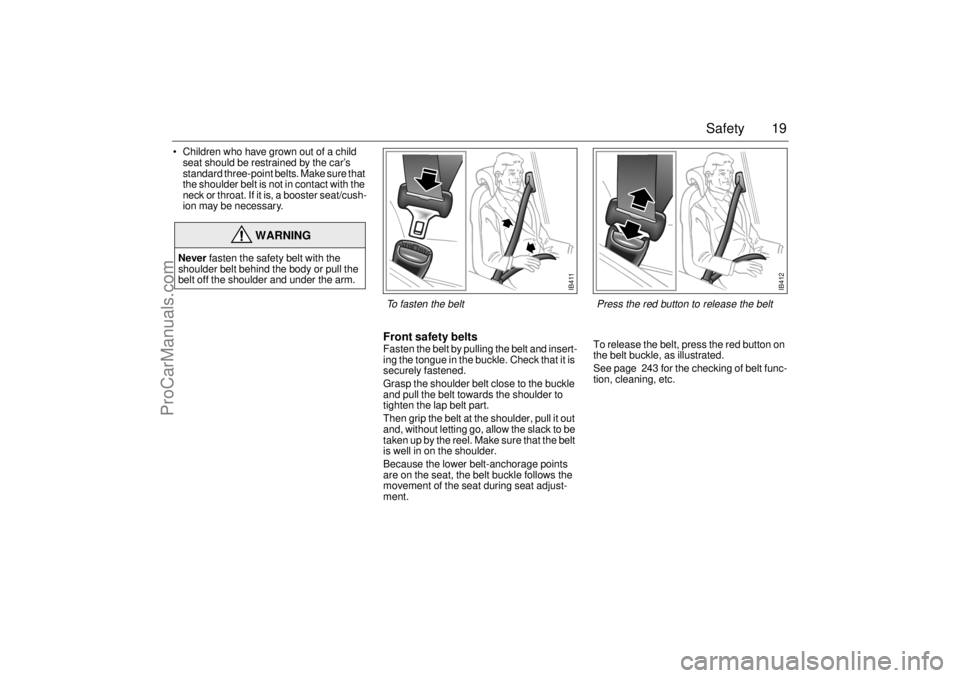
19 Safety
Children who have grown out of a child
seat should be restrained by the car’s
standard three-point belts. Make sure that
the shoulder belt is not in contact with the
neck or throat. If it is, a booster seat/cush-
ion may be necessary.
Front safety belts Fasten the belt by pulling the belt and insert-
ing the tongue in the buckle. Check that it is
securely fastened.
Grasp the shoulder belt close to the buckle
and pull the belt towards the shoulder to
tighten the lap belt part.
Then grip the belt at the shoulder, pull it out
and, without letting go, allow the slack to be
taken up by the reel. Make sure that the belt
is well in on the shoulder.
Because the lower belt-anchorage points
are on the seat, the belt buckle follows the
movement of the seat during seat adjust-
ment.To release the belt, press the red button on
the belt buckle, as illustrated.
See page 243 for the checking of belt func-
tion, cleaning, etc.
WARNING
Never fasten the safety belt with the
shoulder belt behind the body or pull the
belt off the shoulder and under the arm.
IB411
To fasten the belt
IB412
Press the red button to release the belt
ProCarManuals.com
Page 20 of 288
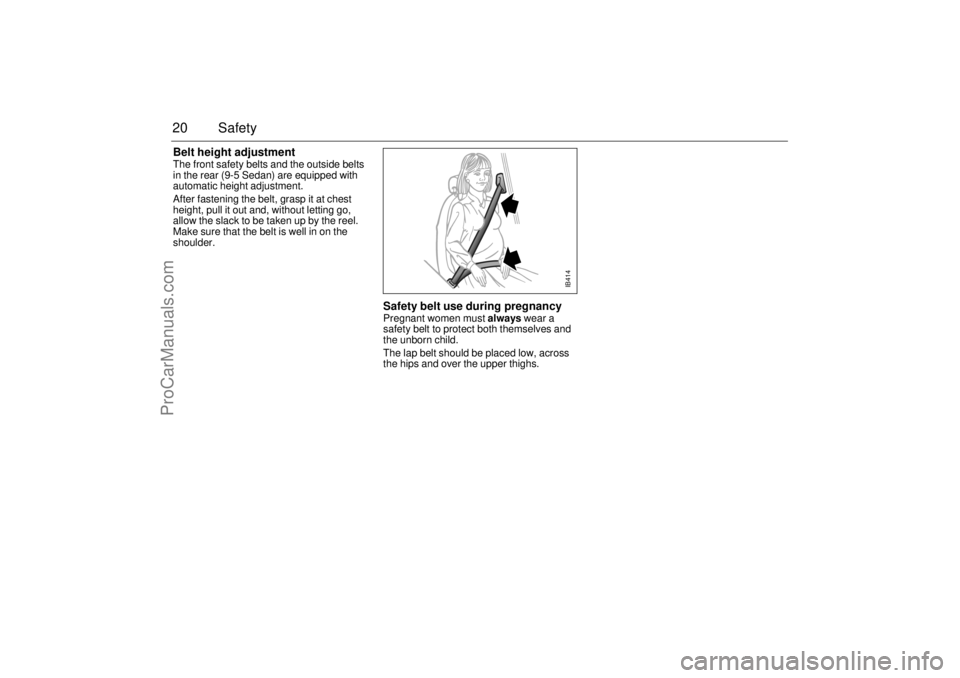
20 SafetyBelt height adjustmentThe front safety belts and the outside belts
in the rear (9-5 Sedan) are equipped with
automatic height adjustment.
After fastening the belt, grasp it at chest
height, pull it out and, without letting go,
allow the slack to be taken up by the reel.
Make sure that the belt is well in on the
shoulder.
Safety belt use during pregnancyPregnant women must always wear a
safety belt to protect both themselves and
the unborn child.
The lap belt should be placed low, across
the hips and over the upper thighs.
IB414
ProCarManuals.com